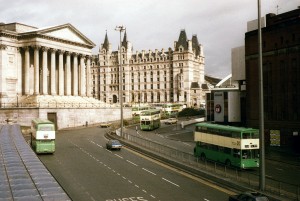Liverpool and other city landscapes
Liverpool Landscapes was a blog charting new discoveries, news and developments affecting Liverpool's historic environment. It was regularly updated between 2007 and 2016.
Liverpool Landscape has now been retired, and most of the less time-dependent articles moved to Historic Liverpool.

This blog, as well as Historic Liverpool (and *ahem* the book!) is all about the historic landscape. It’s about the shape of the city, its growth, and what it’s like to live, work and play in it. So, this round-up of links starts with a bunch not directly linked to Liverpool, but takes a wider view of cities in general, and the people who look deeper into them. It might not be what you think of when you think of Liverpool history, but hopefully it’ll be interesting!
English Heritage’s attempts to revitalise high streets eases us into this blog post. The problems of the high street have become something of a “Thing” in recent years, what with Mary Portas and her well-publicised efforts to give retail a kick up the backside. English Heritage are concerned with the historic landscape of the high street, but of course this is completely tied up with the retail landscape, and the experience of using your local high street on a regular basis. The historic character of the buildings (or lack thereof) can completely change how much you enjoy spending your money in the local economy, with locally-owned businesses. And so you can see how important the seemingly abstract study of history (and architecture and landscape) can affect your everyday quality of life.
Then there are cities without ground, like Hong Kong. I’ve just read this fascinating article about the difficulty in navigating Hong Kong’s different districts. Normal (2D) maps are of little use, and the urban explorer must traverse elephantine escalators between levels, and private- and government- maintained footbridges. In a city with the topography of Hong Kong, ground floors look straight across to 4th floors, and rooftop terraces can look out across the ocean in one direction, and ground floor flats in another. So how do people find their way around? Do they just not bother with Shank’s pony?
Closer to home, prehistory can be found in the most unexpected places. These places are the Urban Prehistorian’s haunts, and the blogger spends most of his posts exploring the Stone Age remains which survive surrounded by the modern city. It’s always an interesting read, but the latest post talks more about the general theme, as opposed to specific sites. He talks about using the presence of prehistoric remains in cities as tools to inspire and raise awareness about history, prehistory and archaeology. Of course, the first things to come to my mind were the Calderstones. Unfortunately, they’re not in their original place, which would place them in the middle of south Liverpool suburbia, but still, the Calderstones are an evocative keyhole glance into Liverpool’s ancient past. Are we making the best use of them?
You may recognise psychogeography in all this waffle, and if you want to really explore that side of things, then the band the Psychogeographical Commission may be worth reading up on. Although the article/interview on the forestpunk website is music-focussed, it’s a great glimpse into modern explorations of the City (with a capital C). The band “use a mixture of folk and rock, cosmic stream-of-consciousness verse, found sounds and electronics to summon the Genius Loci, or the spirit of a place”, which means they try to conjure up the feel of cities in their songs. They want their listeners to stop, listen and think about their urban environments, which is quite similar to what my own writing is about. So even if you don’t care much for the music, read the article. It may make you think a little more actively about where you live.
Finally, let’s put all this into practice. Where English Heritage promote the use of the historic environment in planning, Peel have clearly looked into incorporating the Liverpool landscape in their plans for the north docks, Liverpool Waters. Their document, called the Building Characterisation and Precedent Study, declares in its title how it has looked at the existing landscape when designing its Master Plan. There’s much talk of “scale”, and pages 18 and 19 include a skyline view of the current buildings on the waterfront. There are definitions of the intended neighbourhoods, and how the whole thing will fit together into a whole. It’s a technical document, so you probably just want to flick through it, but it shows how the landscape gets considered across the planning and design process. Let’s hope they get the ‘scale’ right. English Heritage have been skeptical of this so far, haven’t they?
Well, I hope you enjoyed this little tour of landscape investigations in archaeology, music and urban development. Compared to landscape archaeology, the above links point to places where the landscape is looked at in a more ethereal or a more concrete way. That’s the beauty of landscapes: there are infinite approaches to their study, and there are always people trying to make you look at them in a new way, to affect how you look at your own world. If you want to explore another landscape, the landscape of sound and some attempts to “resensitise” yourself to the sound of the city, have a listen to this BBC report on how ‘soundscapes’ can enhance your environment.
Image: Liverpool, Roe Street, early 1980s by Harry Pope. CC by-nc-nd.



